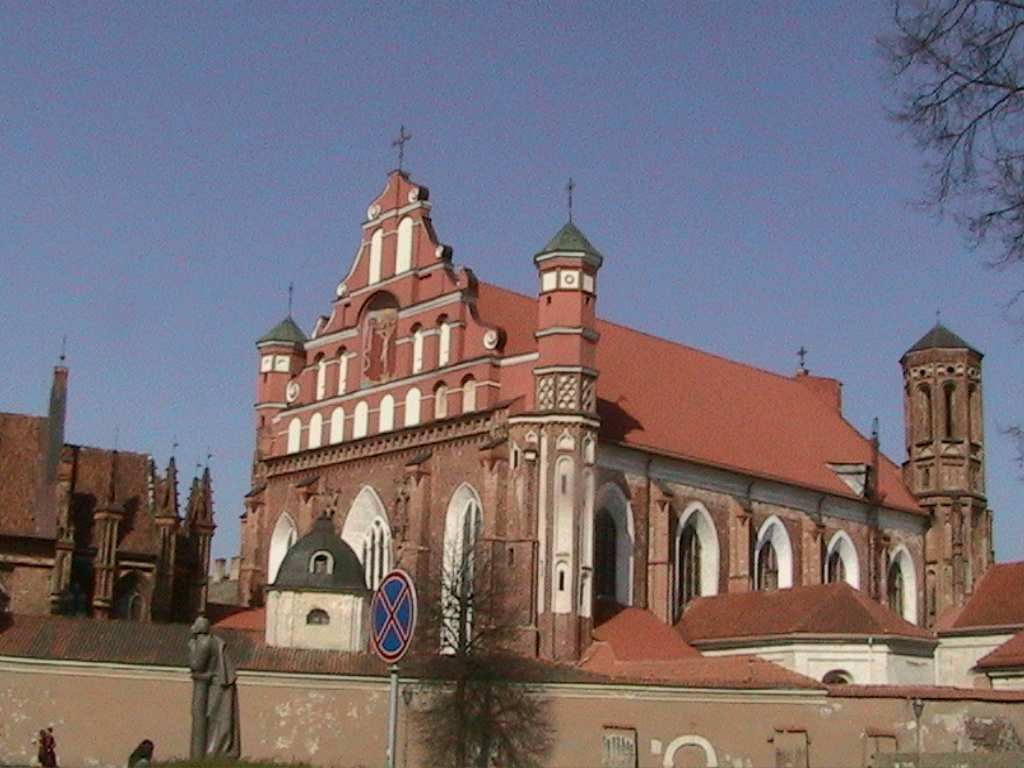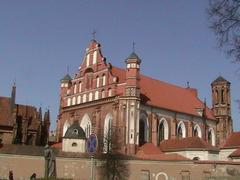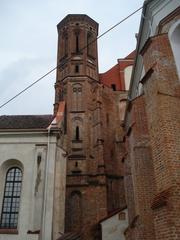
Church of St. Francis and St. Bernard: Visiting Hours, Tickets, and Complete Guide to Vilnius’s Historical Gem
Date: 14/06/2025
Introduction
Rising in the heart of Vilnius Old Town—a UNESCO World Heritage site—the Church of St. Francis and St. Bernard, more widely known as the Bernardine Church, stands as a testament to Lithuania’s medieval legacy and enduring spiritual traditions. Established in the late 15th century by King Casimir IV Jagiellon and built primarily between 1506 and 1516, this remarkable church blends late Gothic and Renaissance architectural styles, featuring distinctive pointed arches, ribbed vaults, and fortress-like elements integral to Vilnius’s former defenses (ldkistorija.lt; History Hit).
Today, the Bernardine Church is celebrated not only for its historical significance but also for its artistic treasures, vibrant cultural events, and accessibility. This guide brings together everything you need to optimize your visit, including up-to-date information on visiting hours, ticketing, accessibility, and nearby attractions. For an enhanced experience, consider downloading the Audiala app for interactive audio guides to the Bernardine Church and other Vilnius landmarks.
Table of Contents
- Introduction
- Historical Overview
- Architecture and Artistry
- Visiting Information
- Travel Tips and Best Visiting Times
- Nearby Attractions
- Safety and Visitor Guidelines
- Frequently Asked Questions
- Conclusion
- References
Historical Overview
Origins and Foundation
The Bernardine Church traces its roots to 1469, when King Casimir IV Jagiellon invited the Franciscans Observants (the Bernardines) to Vilnius. Initially, the monks built a wooden church near the Vilnia River, soon replaced by the enduring brick structure completed in 1516 (ldkistorija.lt).
Architectural Evolution
Gothic Foundations
The church exemplifies late Gothic architecture, with pointed-arch windows, slender buttresses, and an open, light-filled façade. Its ribbed vaults and intricate brickwork are hallmarks of the era, while the profiled buttresses and turrets echo the church’s vertical grandeur (balticdesign.eu).
Defensive Features
Uniquely, the Bernardine Church doubled as a defensive stronghold. Fortified walls, towers with loopholes, and shooting holes were integrated into its structure, providing sanctuary during sieges (ldkistorija.lt).
Later Modifications
The 19th century saw the addition of a neo-Gothic belfry, and the monastery was adapted to educational use in the early 20th century. Despite wartime damage and Soviet-era repurposing, restoration projects have preserved the building’s character (govilnius.lt).
Architecture and Artistry
Exterior Features
The Bernardine Church’s façade features pointed windows, twin octagonal towers, slender buttresses, and turrets, projecting an unmistakable Gothic silhouette (Live the World). The church’s walls and buttresses exemplify the advanced construction methods of its time. Remnants of archers’ holes and defensive towers still speak to its dual role as a sanctuary and fortress (Architektūra Lietuvoje).
Interior Highlights
Frescoes and Wall Paintings
Inside, the sanctuary is divided by soaring pillars supporting ribbed vaults. The 16th-century polychrome frescoes are among the church’s most precious artistic treasures, depicting biblical scenes, hagiographies, and ornamental motifs in a vibrant palette—a reflection of the Renaissance influences blending with Gothic tradition (Live the World).
Altars, Sculpture, and Stained Glass
The main and side altars combine Renaissance and Baroque ornamentation, while the monastic choir and chapels underscore the church’s scholarly and religious importance. The interior features over a dozen side altars adorned with polychromed wooden statues, including a contemplative St. Francis and a host of saints and angels (Visit Lithuania).
Original medieval stained glass windows have been replaced by striking modern installations, most notably the Resurrection window above the main altar (Vilnius Churches).
Pipe Organ and Musical Heritage
A historic pipe organ, installed in the late 19th century, is central to the church’s musical life. The church regularly hosts concerts, including the “Sacred Music Hours” series, attracting performers and audiences from around the world (Vilnius Events).
Visiting Information
Visiting Hours & Tickets
- Hours: Monday–Saturday, 10:00 AM–6:00 PM; Sunday, 12:00 PM–6:00 PM. Closed on major public holidays. Hours may vary for services and special events.
- Admission: Entry is free for worshippers; tourists pay a small fee (€3 for adults, discounts for students/seniors). Children under 7 and EU citizens under 18 enter free. Tickets are available at the entrance or online (Bernardine Parish).
- Guided Tours: Available in multiple languages; advance booking recommended, especially during peak seasons.
Accessibility and Amenities
- Wheelchair Access: The main entrance has ramps; accessible restrooms are available. Some historic areas may have limited access.
- Facilities: Restrooms, information desk, and gift shop are on-site. Brochures are provided in several languages.
Dress Code and Visitor Etiquette
- Dress Modestly: Shoulders and knees should be covered; hats removed inside.
- Silence and Respect: Maintain a quiet atmosphere, especially during Mass. Photography is allowed without flash or tripods, except during services.
Guided Tours & Events
Guided tours (45–60 minutes) are available in English, Lithuanian, Russian, and Polish, delving into the church’s history, art, and restoration. The church also hosts cultural events, concerts, and festivals like the Feast of St. Francis and Bernardine Days (Bernardine Days).
Travel Tips and Best Visiting Times
- Best Seasons: Late spring and early summer (May–June) offer mild weather and manageable crowds (whereandwhen.net).
- Quiet Hours: Arrive early or late afternoon for a peaceful visit.
- Combine Visits: Pair your visit with nearby attractions like St. Anne’s Church, Bernardine Garden, and Užupis district for a full day’s experience (atickettotakeoff.com).
- Public Transport: Easily accessible by bus or trolleybus; parking is limited in Old Town.
Nearby Attractions
- Church of St. Anne: A flamboyant Gothic masterpiece adjacent to the Bernardine Church.
- Bernardine Garden: A tranquil park ideal for relaxation.
- Užupis District: Vilnius’s bohemian neighborhood, just across the Vilnia River.
- Cathedral Square, Vilnius University, and the Palace of the Grand Dukes: All within walking distance.
Safety and Visitor Guidelines
The church is located in a safe, central area. Remain mindful of personal belongings during busy events. For the latest health and safety protocols, consult official announcements before your visit.
Frequently Asked Questions (FAQ)
Q: What are the Bernardine Church’s visiting hours?
A: Monday–Saturday, 10:00–18:00; Sunday, 12:00–18:00. Hours may change for services or events.
Q: Is there an entry fee?
A: Entry is free for worshippers. Tourists pay €3, with reductions for students and seniors.
Q: Are guided tours available?
A: Yes, in multiple languages. Book in advance during busy periods.
Q: Is the church wheelchair accessible?
A: Yes, with ramps and accessible restrooms. Some areas may remain inaccessible due to historic design.
Q: Can I take photos inside?
A: Yes, except during services and without flash/tripods.
Q: How do I reach the church by public transport?
A: Several bus and trolleybus routes stop nearby; the church is also walkable from central Vilnius.
Conclusion
The Bernardine Church is an unmissable highlight for anyone exploring Vilnius. Its awe-inspiring architecture, preserved frescoes, vibrant musical and cultural life, and prime location within Vilnius Old Town make it an essential stop for history enthusiasts and casual visitors alike. Plan ahead, respect the sacred atmosphere, and immerse yourself in one of Lithuania’s most storied landmarks.
For further information, tickets, and up-to-date schedules, visit the official church and tourism websites. Download the Audiala app for a richer, interactive experience during your visit.
References and Further Reading
- Visiting the Bernardine Church in Vilnius: History, Tickets, and Travel Tips (ldkistorija.lt)
- Visiting the Bernardine Church in Vilnius: Hours, Tickets, and Historical Highlights (History Hit)
- Bernardine Church Vilnius: Visiting Hours, Tickets & Artistic Treasures (Vilnius Tourism)
- Bernardine Church Vilnius Visiting Hours, Tickets, and Visitor Guide (atickettotakeoff.com)
- Official Vilnius Tourism Website (govilnius.lt)
- Bernardine Parish Official Site (bernardinuparapija.lt)
- Architektūra Lietuvoje (Architektūra Lietuvoje)




























































































